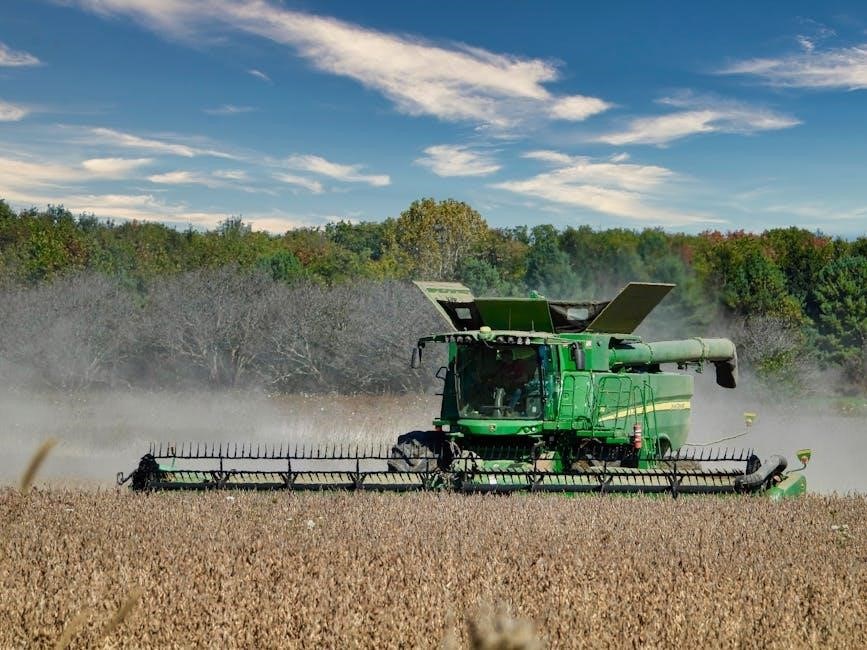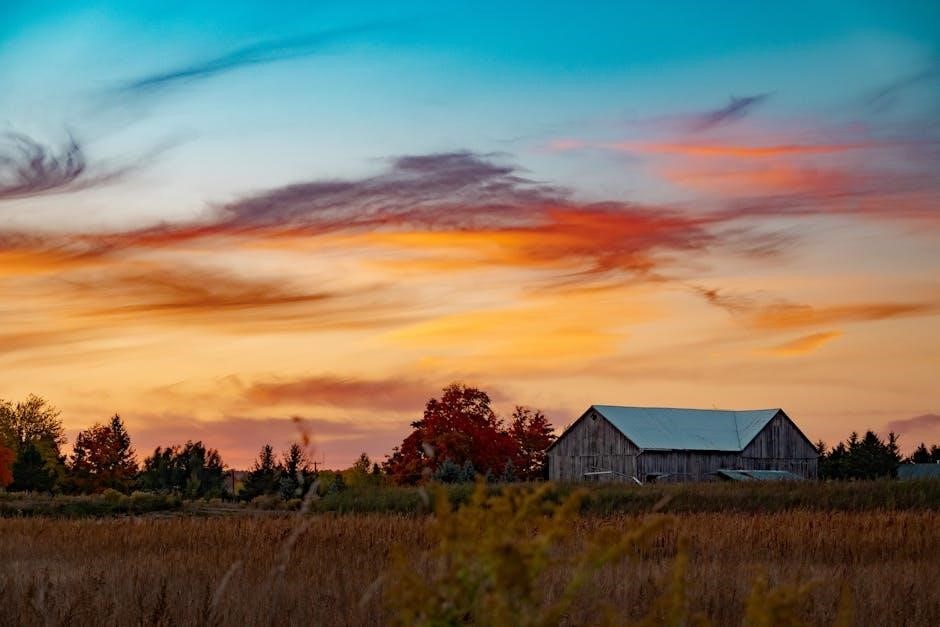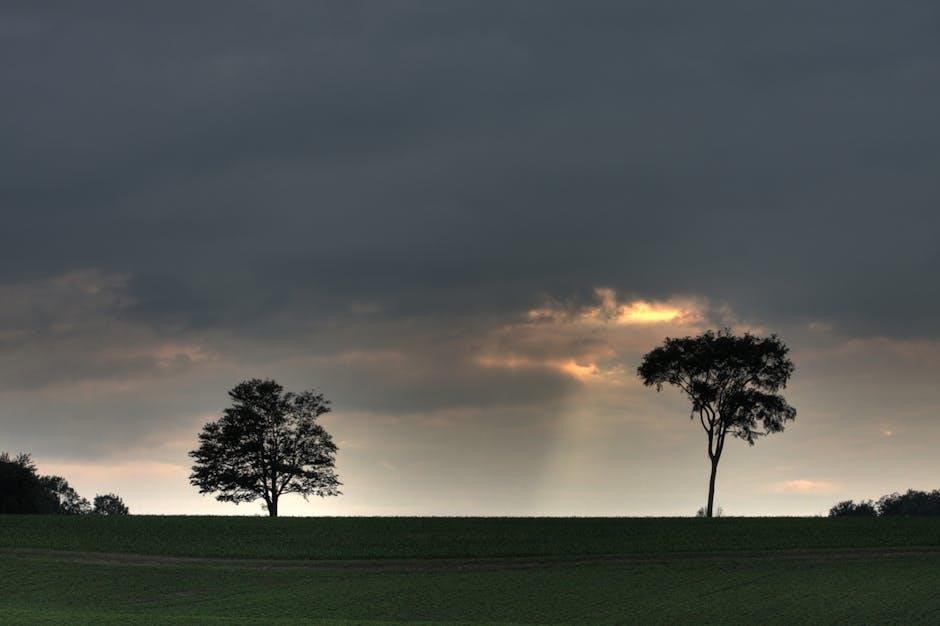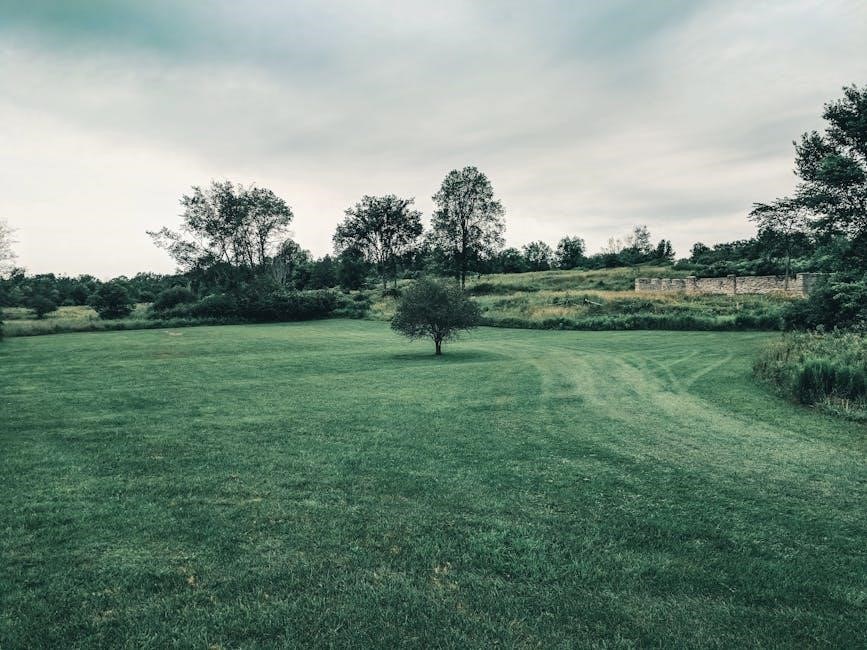A Field Guide to Trees of Ontario provides essential insights into the province’s diverse tree species, offering detailed descriptions, visual aids, and identification tips. It covers both native and cultivated trees, highlighting their ecological significance and practical uses. This resource is invaluable for nature enthusiasts, researchers, and conservationists, fostering a deeper appreciation and understanding of Ontario’s arboreal heritage.
Overview of Ontario’s Tree Species
Ontario is home to a diverse range of tree species, including both deciduous and coniferous varieties. Native species such as the sugar maple, eastern white pine, and trembling aspen are widely distributed across the province. These trees thrive in various habitats, from urban landscapes to vast forests, and play a critical role in Ontario’s ecosystems. The province’s tree species are characterized by unique features, such as leaf shape, bark texture, and needle structure, which aid in identification. Additionally, Ontario’s climate supports the growth of cultivated species, introduced for their ornamental or economic value. Understanding these species is essential for conservation, forestry, and environmental stewardship. This guide provides a comprehensive overview, helping readers recognize and appreciate the rich arboreal diversity of Ontario.
Importance of Tree Identification
Importance of Tree Identification
Accurate tree identification is crucial for ecological conservation, sustainable forestry, and environmental stewardship. It enables the protection of endangered species and habitats, ensuring biodiversity. Identifying trees helps in understanding their roles in ecosystems, such as supporting wildlife and regulating climate. For urban planning, knowing tree species aids in creating green spaces that enhance city livability. Tree identification also supports cultural and historical preservation, as certain species hold significance for Indigenous communities and Ontario’s development. By recognizing tree species, individuals can contribute to their conservation and sustainable use, fostering a deeper connection with nature. This guide equips readers with the knowledge to identify and appreciate Ontario’s trees, promoting informed decision-making for environmental and societal benefits.

Tree Identification Basics
Understanding basic tree features like leaves, bark, and growth habits is essential. Recognizing habitat and using field guides or apps aids accurate identification. This foundation helps in detailed species recognition.
Key Features for Identification

Identifying Ontario’s trees begins with observing key features such as leaves, bark, and fruit. Leaf shape, arrangement, and venation patterns are crucial, as they vary significantly between species. Bark texture, color, and markings also provide valuable clues, especially in winter when leaves are absent. Fruit types, like nuts, cones, or berries, are additional identifiers. Growth habits, such as tree size and branch structure, further aid in distinguishing species. Seasonal changes, like fall color or budding patterns, can also be helpful. Understanding these features, along with habitat and site conditions, ensures accurate identification. This approach allows enthusiasts and researchers to effectively navigate Ontario’s diverse tree species, whether in urban or natural settings. By focusing on these elements, anyone can become proficient in identifying the province’s rich arboreal diversity.
Tools and Resources for Tree Identification
Accurate tree identification in Ontario relies on a combination of tools and resources. Field guides, such as A Field Guide to Trees of Ontario, provide detailed descriptions, images, and maps to help recognize species. Online databases, like the Ontario Tree Atlas, offer interactive maps and searchable databases. Mobile apps, such as Leafsnap or iNaturalist, enable users to identify trees using images of leaves, bark, and fruit. Additionally, consulting with local botanists, foresters, or joining botanical clubs can provide expert insights. Tools like magnifying glasses and measuring tapes are useful for examining leaf venation or tree height. Workshops and webinars, such as those hosted by Ontario’s conservation organizations, further enhance identification skills. These resources collectively empower individuals to confidently identify and explore Ontario’s diverse tree species, whether in urban parks or wilderness areas.

Deciduous Trees of Ontario
Ontario’s deciduous trees, such as Sugar Maple, Red Oak, and White Birch, are known for their vibrant fall colors and diverse growth habits, adapting to various habitats across the province.
Common Species and Their Characteristics
Ontario is home to a variety of deciduous tree species, each with unique characteristics. The Sugar Maple (Acer saccharum) is renowned for its bright fall colors and distinctive lobed leaves. The Red Oak (Quercus rubra), with its pointed lobes and reddish foliage, thrives in well-drained soils. The White Birch (Betula papyrifera) is easily recognizable by its white, peeling bark and slender branches. Other common species include the Yellow Birch and Black Cherry, each adapted to specific habitats. These trees play crucial roles in Ontario’s ecosystems, supporting wildlife and contributing to the province’s natural beauty. Understanding their characteristics aids in identification and appreciation of the region’s rich arboreal diversity.
Identifying Leaves, Bark, and Fruit
Accurate tree identification in Ontario often relies on examining leaves, bark, and fruit. Leaves vary in shape, size, and arrangement, with patterns like alternate, opposite, or whorled helping distinguish species. For example, the Sugar Maple has palmate leaves with deep lobes, while the Red Oak features pointed lobes. Bark texture and color also provide clues: the White Birch has striking white, peeling bark, while the Eastern White Pine exhibits reddish-brown, scaly bark. Fruit, such as acorns, cones, or samaras, offers additional evidence. Observing these features collectively ensures precise identification. Using field guides with detailed illustrations and descriptions enhances the process, making it easier to recognize Ontario’s diverse tree species accurately. By focusing on these key characteristics, enthusiasts can deepen their understanding of the province’s arboreal landscape.
Coniferous Trees of Ontario

Ontario’s coniferous trees, such as the Eastern White Pine, Red Pine, and Black Spruce, are evergreen, retaining their needle-like leaves year-round. Native species dominate the province’s forests, providing habitat and supporting biodiversity through their needle arrangements and cone production.
Native Evergreen Species
Ontario’s native evergreen species, such as the Eastern White Pine, Red Pine, and Black Spruce, are integral to the province’s forests. These conifers are adapted to Ontario’s climate, with needle-like leaves that retain moisture and withstand cold temperatures. The Eastern White Pine is one of the largest native conifers, often found in well-drained soils, while the Black Spruce thrives in wetlands and boreal regions. These trees play a crucial role in supporting local wildlife, providing shelter and food for birds, insects, and small mammals. Their ability to grow in diverse conditions makes them resilient and ecologically vital. Understanding their characteristics, such as needle color, arrangement, and cone structure, aids in identification and appreciation of these enduring species.
Distinguishing Features of Needles and Cones

Identifying Ontario’s coniferous trees often begins with examining their needles and cones. Needles vary in color, length, and arrangement, with species like the Eastern White Pine featuring soft, blue-green needles in bundles of five, while the Red Pine has longer, twisted needles in pairs. The Black Spruce has short, stiff needles with a prickly texture. Cones also serve as key identifiers, differing in shape, size, and texture. Eastern White Pine cones are long and cylindrical, while Red Pine cones are shorter and rounded. Balsam Fir cones are upright and resinous. These features, along with growth habits and habitat preferences, help distinguish between native evergreen species. Observing these characteristics is essential for accurate identification and appreciation of Ontario’s coniferous trees.

Tree Habitats and Distribution
Ontario’s diverse landscapes support a wide range of tree species, from boreal forests to deciduous woodlands. Climate, soil, and geography shape distribution, with native and cultivated trees thriving in urban and rural areas.
Forest Types and Tree Distribution
Ontario’s forests are categorized into distinct types, each supporting specific tree species. Boreal forests dominate the north, featuring conifers like black spruce and jack pine. Deciduous forests in the south include sugar maple and oak. Mixed woodlands combine elements of both, fostering diversity. Tree distribution is influenced by climate, soil, and topography. For instance, lowland areas often host silver maple and willow, while upland regions favor pine and red maple. Urban environments, with their varied conditions, support a mix of native and cultivated species. Understanding these forest types and their tree distributions is key to effective conservation and management, ensuring the sustainability of Ontario’s arboreal ecosystems for future generations.
Urban vs. Rural Tree Growth
Tree growth in urban and rural areas of Ontario differs significantly due to environmental and human factors. Urban trees often face challenges such as pollution, soil compaction, and limited space, affecting their health and longevity. Species like the Norway maple and silver birch are commonly found in cities, adapting to these conditions. In contrast, rural areas provide more natural habitats, allowing native species like sugar maple and pine to thrive. Urban trees are frequently planted for aesthetic and ecological benefits, while rural trees play a crucial role in sustaining ecosystems and wildlife. Understanding these differences is vital for effective tree management and conservation strategies tailored to each environment. This guide helps identify and address the unique needs of trees in both settings, promoting healthier growth across Ontario;
Ecological Role of Trees
Trees are vital for supporting ecosystems, providing food and shelter for wildlife, and maintaining biodiversity. They play a key role in carbon sequestration, helping regulate the climate and ensure environmental balance.
Supporting Wildlife and Ecosystems

Trees play a crucial role in sustaining Ontario’s ecosystems by providing habitat, food, and shelter for diverse wildlife. They support pollinators like bees and butterflies, which are essential for flower and seed production. Native tree species such as maple, oak, and pine attract various bird species, while their fruits, nuts, and leaves serve as vital food sources for mammals, insects, and birds. Forests also create complex microhabitats for insects and small mammals, fostering biodiversity. Additionally, trees protect soil from erosion and maintain water quality, ensuring healthy habitats for aquatic life. This interconnected relationship highlights the importance of preserving Ontario’s tree populations to maintain ecological balance and support wildlife diversity.
Carbon Sequestration and Climate Regulation
Trees in Ontario play a vital role in carbon sequestration, absorbing carbon dioxide from the atmosphere and storing it in their biomass, soil, and deadwood. This natural process helps mitigate climate change by reducing greenhouse gases. Forests act as massive carbon sinks, with species like maple, oak, and pine contributing significantly to carbon storage. Trees also produce oxygen through photosynthesis, improving air quality. Additionally, they regulate local climates by providing shade, moderating temperatures, and influencing precipitation patterns. Healthy tree populations are essential for maintaining ecological balance and combating global warming. Protecting and expanding Ontario’s forests is critical for enhancing carbon sequestration efforts and ensuring a sustainable future. By preserving these natural assets, we can effectively address climate change while supporting biodiversity and ecosystem health.

Cultural and Historical Significance
Trees in Ontario hold deep cultural and historical value, featuring prominently in Indigenous traditions, early settlement life, and symbolic provincial emblems, reflecting their enduring importance to the region’s heritage.
Indigenous Uses of Trees
Indigenous communities in Ontario have traditionally relied on trees for various essential purposes. For centuries, they have used trees for food, medicine, shelter, and tools. For instance, the bark of birch trees was used to make canoes and dwellings, while the sap of maple trees provided a vital source of nutrition. Many tree species were also integral to spiritual practices, with certain trees holding sacred significance in rituals and ceremonies. Indigenous peoples developed a profound understanding of the forest ecosystem, utilizing every part of the tree to sustain their communities. This knowledge has been passed down through generations, emphasizing a deep connection to nature and sustainable practices. Their reliance on trees highlights the importance of preserving these traditions and respecting the land’s rich cultural heritage.
Historical Importance in Ontario’s Development
Trees have played a pivotal role in Ontario’s historical development, shaping its economy, infrastructure, and cultural identity. The province’s vast forests were a cornerstone of early settlement, providing timber for construction, fuel for heating, and materials for furniture and tools. The logging industry dominated Ontario’s economy during the 19th and early 20th centuries, with species like white pine and red pine being highly prized. The fur trade also relied on tree-based resources, such as birchbark for canoes and cedar for roofing. Trees additionally supported transportation, with wooden ships and railways built from native timbers. As urbanization grew, trees were planted in cities to beautify and shade public spaces, reflecting a growing appreciation for their aesthetic and environmental value. This historical reliance on trees underscores their enduring impact on Ontario’s growth and identity.
Conservation and Management
Conservation and management of Ontario’s trees focus on preserving habitats and ensuring sustainable practices. Efforts include protecting endangered species, reforestation, and responsible logging to maintain biodiversity and ecological balance.

Protecting Endangered Tree Species
Conservation efforts in Ontario focus on safeguarding endangered tree species, such as the Red Mulberry and Butternut, which face threats from habitat loss, climate change, and invasive pests. Monitoring programs and research initiatives are essential to track population declines and implement recovery strategies. Legal protections, like Ontario’s Endangered Species Act, play a crucial role in preventing further loss. Collaborative efforts between government agencies, conservation organizations, and local communities are vital to ensure the survival of these species. Reforestation projects and habitat restoration also contribute to creating suitable environments for endangered trees. Public awareness campaigns educate individuals about the importance of conservation and how to support these efforts. Protecting these species is not only about preserving biodiversity but also about maintaining the ecological balance and heritage of Ontario’s forests.
Sustainable Forestry Practices
Sustainable forestry practices in Ontario aim to balance economic, social, and environmental needs while maintaining healthy, productive forests. These practices include selective logging, reforestation, and habitat preservation to ensure long-term forest health. Certification programs, such as the Forest Stewardship Council (FSC), promote responsible forestry by setting strict environmental and social standards. Public and private landowners are encouraged to adopt these practices to protect biodiversity and reduce the impact of logging on ecosystems. Education and community involvement are key to fostering a culture of sustainability. By prioritizing ecological integrity, Ontario’s forests can continue to provide resources while supporting wildlife and mitigating climate change. These efforts ensure that future generations can benefit from the province’s rich forest heritage.
Practical Uses of Trees
Trees provide essential resources like timber, wood products, furniture, pulp, and paper, while also offering sustainable materials for biofuels and eco-friendly alternatives, supporting both traditional and modern industries.
Timber and Wood Products
Trees in Ontario are a vital source of timber and wood products, supporting industries and daily life. Species like maple, oak, and pine are prized for their durable wood, used in furniture, construction, and flooring. Sustainable forestry practices ensure the long-term availability of these resources. Wood byproducts, such as pulp and paper, are essential for manufacturing and packaging. Additionally, wood residues are repurposed into biofuels and bioproducts, offering eco-friendly alternatives. The forestry sector plays a crucial role in Ontario’s economy, providing employment and fostering innovation. By prioritizing sustainable harvesting and reforestation, Ontario maintains its forests while meeting the demand for wood-based materials, ensuring a balance between economic growth and environmental stewardship.
